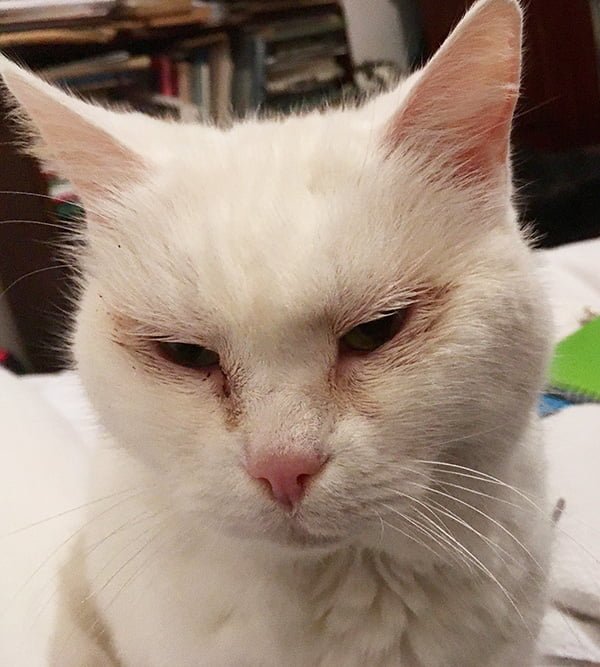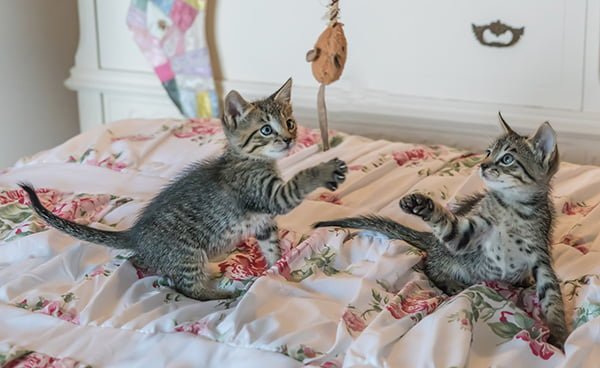There are many conditions that can affect your cat’s eyes, and conjunctivitis is one of the most common. Frequently associated with viral diseases such as herpesvirus, conjunctivitis leads to a red, swollen eye. While mild cases may resolve without treatment, eye issues in cats can be painful and progress quickly. Therefore it is always important to see your veterinarian as soon as possible if you have any concerns.
What is Conjunctivitis in Cats?
Conjunctivitis, also referred to as “pink eye,” is a broad term referring to inflammation of the conjunctiva, the mucous membrane that covers your cat’s eyeball and the inner part of the eyelids. Cats also have a third eyelid (nictitating membrane) that is covered by conjunctiva and not normally visible.
Inflammation leads to red, warm, swollen, and painful tissue. There are many possible underlying causes of conjunctivitis, some of which are associated with infection (such as feline herpesvirus), allergies, or injury to the eye.
Although cats of any age can get conjunctivitis, it is most commonly seen in young animals or those living with multiple other cats (such as in catteries or animal shelters). Conjunctivitis can affect one or both eyes.
Symptoms of Cat Conjunctivitis
In normal cats, the conjunctiva is pale pink and not easily visible, and the third eyelid is retracted. Symptoms of conjunctivitis may involve one or both eyes and vary based on the underlying cause, but often include:
Redness and swelling of the tissue around the eyeball
Ocular (eye) discharge - may be clear, cloudy, yellow, or green
Squinting or blinking - may be a sign of pain
Pawing or rubbing at the face
It may or may not be associated with nasal discharge, sneezing, coughing, or other signs of illness
How do Cats Get Pink Eyes?
Conjunctivitis refers to inflammation and may be due to many possible underlying causes. A veterinary exam and diagnostic testing will be needed to determine the underlying cause and the best treatment options for your cat. Common causes include:

Source: Flickr
Infection
Infection is the most common cause of conjunctivitis in cats and can be caused by a virus, bacteria, or less commonly fungal or parasitic agents. A few of the common culprits are discussed below.
Feline rhinotracheitis (herpesvirus-1)
This is the number one cause of conjunctivitis in cats. It is a viral infection that is also associated with upper respiratory symptoms such as runny nose, sniffles, sneezing, nasal discharge, eye discharge, cough, fever, and possible ulceration of the eyes, nose, and mouth. In most cases, the infection lasts 10-20 days. However, the virus can lie dormant in the body for long periods of time and then cause a recurrence of symptoms, usually in times of stress. This condition tends to be most severe in kittens and, in the worst cases, can cause eye rupture and blindness.
Herpes is highly contagious in cats and is spread via saliva and discharge from the eyes and nose of infected cats. Cats may also become infected by contact with fomites (objects that carry infection) such as food and water bowls, clothing, and furniture.
Treatment usually involves topical antibiotics placed into the eyes(s). Depending on the severity and other clinical signs, oral antibiotics or antiviral medications may also be indicated. Nursing care to encourage eating and maintain hydration are also important, especially in sick kittens.
Calicivirus
This is another common virus associated with upper respiratory infections in cats. Along with other upper respiratory symptoms, cats with this virus also tend to get painful ulcers in their mouths. This virus is also highly contagious among cats.
Bacterial infections
Oftentimes a viral infection can lead to secondary bacterial infections, including overgrowth of the bacteria naturally inhabiting the eye. Sometimes bacteria can also be the primary cause of conjunctivitis. Chlamydia and Mycoplasma are two bacteria frequently associated with conjunctivitis in cats and they can be treated with topical or oral antibiotics.
Environmental irritants or allergies
Allergies in cats commonly cause pruritus (itchy skin) and predispose them to skin and ear infections. However, some cats with environmental allergies can also present with red and watery eyes. Irritants, including chemicals, dust, or foreign bodies such as pieces of plant material, are also possible causes of allergic conjunctivitis.
Corneal ulcer
An ulceration of the cornea can occur as a result of viral infection, foreign body, or injury. This condition is extremely painful and should be addressed by a veterinarian right away. Treatment usually involves topical medications and an E-collar to prevent additional rubbing or pawing.
Keratitis
Inflammation of the cornea, known as keratitis, is sometimes seen along with conjunctivitis and may occur secondary to viral infections or for other reasons. Eosinophilic keratitis causes raised white, tan, or grey lesions on the surface of the eye(s), painful eyes, and thick ocular discharge. Treatment usually involves long-term immunosuppression with topical steroids. However, in severe cases, oral or injectable medications or surgery, may also be recommended.
Immunocompromised
Cats who are immunocompromised, including those who are positive for feline immunodeficiency virus (FIV) or feline leukemia virus (FeLV), are more susceptible to cat conjunctivitis.
Other
Other less common causes of conjunctivitis in cats include:
Dry eye - Insufficient tear production can lead to a dry, red, irritated eye. Decreased tear production may also be associated with herpesvirus in cats.
Abnormal eyelid formation - Entropion (folding inward of the eyelid) may be seen in Persians and other long-haired breeds. When the eyelids and lashes rub on the eye it causes irritation.
Mass or tumor in or surrounding the eye
Glaucoma or uveitis may also cause a red, irritated eye.
How is Conjunctivitis In Cats Diagnosed?
A presumptive diagnosis of conjunctivitis is based on history and physical exam. There are also several tests that your vet may recommend to further evaluate your cat's eyes and rule out other issues.
Fluorescein stain - This test checks for the presence of a corneal injury or ulcer. A small amount of stain is applied to the eye, which will stick to areas of ulceration and glow under black light.
Schmear tear test - This test is used to measure tear production. It involves placing the tip of a special filter paper inside the lower eyelid and waiting for 60 seconds.
Tonometry - This test involves gently touching the surface of the eye with a Tonopen to measure pressures within the eye. Intraocular pressure may be elevated in glaucoma or decreased in uveitis.
Additionally, your vet may perform a fundic exam to evaluate the back of your cat’s eye. In some cases, they may also recommend referral to an ophthalmologist.
While specific tests are available for the common viruses and bacteria frequently associated with infectious conjunctivitis, these are not usually indicated. For one reason, these pathogens are so common that many cats will test positive even if they do not have an active infection. For another, it does not usually change the recommended course of treatment. Additional testing may be discussed in more complex cases.
Treatment for Conjunctivitis
In some cases mild conjunctivitis may resolve on its own, however, any issue involving an animal’s eye should always be evaluated by a vet. Treatment recommendations from your vet will be based on the severity of the condition and the underlying cause. Common treatments may include:
Antibiotic eye drops or ointment - the most common treatment to control secondary bacterial infection
Oral antibiotics
Oral or topical antiviral medications
Oral or topical steroids to decrease inflammation
Nursing care - This may include warming canned food to encourage eating (some cats may refuse to eat if their nose is stuffy and they can’t smell their food), humidification, and subcutaneous fluids if necessary.
Cone of shame - If your cat is pawing or rubbing at their eyes, an E-collar may be needed to prevent additional damage until treatments begin to work.
Good hygiene and decontamination of the environment to prevent the spread to other cats
Most cases of feline conjunctivitis will resolve within a couple of weeks of appropriate treatment, with improvement noted within the first few days. However, this condition is common and has a tendency to recur, especially in times of stress. There is no cure for herpesvirus, but most cats respond well to medical management aiming to decrease the frequency and severity of flare-ups.
How to Prevent Conjunctivitis
Vaccines are available for certain infectious causes of conjunctivitis. FVRCP is a core vaccine recommended for all felines and protects against herpesvirus and calicivirus (as well as panleukopenia). While vaccination does not completely prevent infection, it significantly decreases the severity and length of illness. There is also a vaccine available for Chlamydia, however, it is usually only recommended in certain high-risk situations.
Decreasing stress via environmental modification, enrichment, Feliway, and certain supplements, such as Fortiflora (a probiotic), lysine, and hyaluronate eye drops, may also be helpful.
Other causes of conjunctivitis are more difficult to prevent. If your cat has an allergy, avoiding environmental irritants and gently cleaning their eyes may also be beneficial. Using good hygiene and separating cats who are ill can also help prevent the spread of disease.

Source: Pixabay
FAQ
Is conjunctivitis in cats contagious?
Herpesvirus is extremely contagious among cats, but luckily cannot be spread to people (just as human herpes cannot be spread to cats). A person, however, may help facilitate the spread between cats via contaminated hands or clothing. Therefore it is always a good idea to use good hygiene and keep infected cats separate from other felines in the household for approximately three weeks after the onset of symptoms or based on your vet’s recommendations. This is especially important if your household has kittens or unvaccinated adult cats.
Bacterial causes of conjunctivitis can, in rare cases, be spread to dogs or people. Practice good hygiene and contact your doctor with any questions or concerns.
Is conjunctivitis in cats contagious to dogs?
Depending on the underlying cause, some bacterial infections may be spread to dogs and people.
Can cat conjunctivitis heal on its own?
It is possible for mild cases of conjunctivitis and upper respiratory infections to resolve on their own without treatment. However, any issue involving an animal’s eye should be evaluated by a vet. If your cat seems uncomfortable, is not eating, has other worrying clinical signs, or is not improving, you should contact your veterinarian immediately. In the worst-case scenarios, conjunctivitis can cause long-term complications such as keratitis, corneal sequestrum, and blindness.
How do you give eye drops to a cat's eye?
Applying medication to a wiggly cat’s eye can be difficult and intimidating. On top of that, many eye medications must be applied several times per day. Some ophthalmic medications come in either drops or ointment, and you may find that one form is easier than the other. Your veterinary team can give you a demonstration in the clinic, and many great videos are available online as well. In general, it is best to hold your cat close to your body and come from behind to apply the drops. Never let the bottle touch their eye. Be sure to pair the experience with lots of positive reinforcement like treats and praise.
